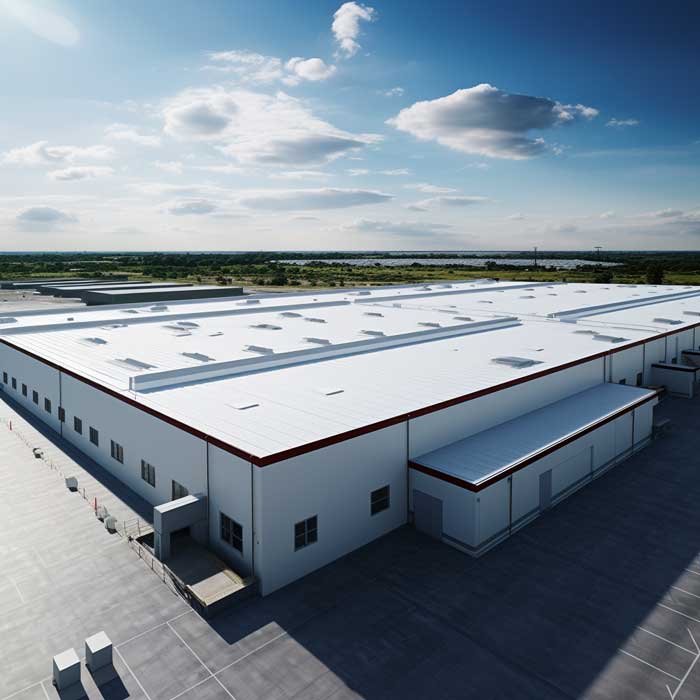Thermoplastic (PVC & TPO) Roof Membranes: Modern Solutions for Commercial Roofing

Thermoplastic membranes, particularly Polyvinyl Chloride (PVC) and Thermoplastic Olefin (TPO), represent a significant advancement in commercial roofing technology. Their combination of durability, flexibility, and eco-friendly attributes makes them a compelling choice for modern commercial buildings. With brands like Weatherbond Roofing Systems leading the way in quality and innovation, PVC and TPO roofs are well-positioned to meet the diverse and evolving needs of the commercial roofing market. Whether prioritizing longevity, environmental impact, or cost-effectiveness, thermoplastic roofing systems offer solutions that are both practical and forward-thinking.
Description and Key Features
Thermoplastic roof membranes, specifically PVC and TPO, are known for their durability, flexibility, and resistance to environmental factors. These single-ply roofing systems are lightweight, easy to install, and highly resistant to chemicals, UV light, and fire. PVC, with its long track record, and TPO, recognized for its growing popularity and advanced features, are both excellent choices for modern commercial roofing needs.
Composition
PVC roofing membranes are made from a combination of polyvinyl chloride resins, plasticizers for flexibility, and various additives for resistance to UV rays, microbes, and chemicals. TPO membranes, on the other hand, are made from ethylene-propylene rubber combined with polypropylene and typically do not contain plasticizers. Both PVC and TPO are available in various thicknesses and can include reinforced layers for added strength.
Benefits
The primary benefits of PVC and TPO roofing systems include their excellent waterproofing capabilities, high resistance to tears and punctures, and superior energy efficiency. PVC roofs are particularly known for their longevity and resistance to chemical exposure, while TPO roofs offer exceptional heat-welded seam strength and are often preferred for their environmentally friendly qualities.
Climate Considerations
Both PVC and TPO roofing systems perform well in various climates. Their heat-welded seams provide excellent protection against leaks, making them suitable for areas with heavy rainfall. In hot climates, white or light-colored PVC and TPO membranes can reflect sunlight, reducing cooling costs. They are also resistant to the damaging effects of UV radiation and ozone.
Building Design and Purpose
Thermoplastic roofs are adaptable to various commercial building designs, particularly those with low-slope or flat roofs. They are an excellent choice for buildings that require a lightweight roofing solution with strong performance characteristics. These roofs are also ideal for buildings that house sensitive equipment or operations due to their resistance to chemicals and pollutants.
Advantages and Disadvantages
The advantages of PVC and TPO roofing include their long lifespan, strong resistance to environmental factors, and energy efficiency. However, the quality of installation is crucial for their performance, as poor installation can lead to seam failures and leaks. TPO, being relatively newer in the market, has variations in formulation between manufacturers, which can affect its long-term performance.
Cost and Longevity
The initial installation cost for PVC and TPO roofing systems can vary, with PVC generally being on the higher end due to its established reputation and longevity. TPO offers a more cost-effective alternative with a slightly shorter lifespan but still provides excellent value over time. Both types of roofs require minimal maintenance, adding to their cost-effectiveness.
Popular Brands: Weatherbond Roofing Systems
Weatherbond Roofing Systems is a notable brand in the thermoplastic roofing industry, offering a range of high-quality PVC and TPO products. Their membranes are known for their durability, ease of installation, and strong performance characteristics. Weatherbond’s products are backed by comprehensive warranties, ensuring reliability and customer satisfaction.
Maintenance Requirements
Maintenance for PVC and TPO roofs typically involves regular inspections, cleaning to remove debris and dirt, and checking for any signs of wear or damage, particularly at seams and flashings. Repairs, if needed, can be easily conducted with compatible materials. Proper maintenance ensures the longevity and effectiveness of these roofing systems.
